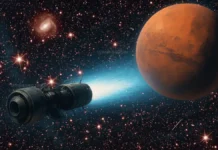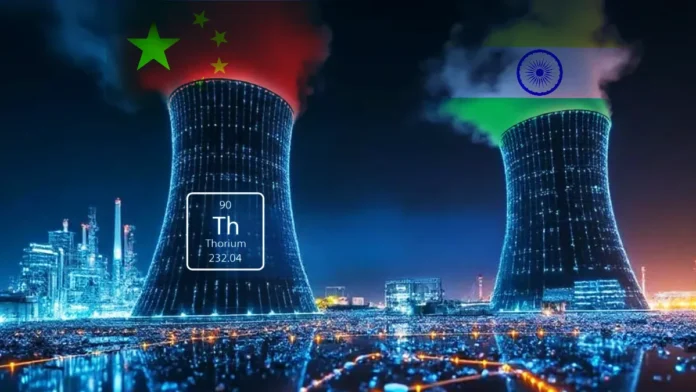
India holds one of the world’s largest reserves of thorium, a silvery radioactive metal often described as the nuclear fuel of the future. Yet, despite this natural endowment and an early visionary roadmap designed around thorium nuclear energy in India, the country has made negligible progress in commercial deployment. Meanwhile, countries like China are making strategic investments and technological strides in thorium-fueled molten salt reactors (MSRs). The stark contrast between India’s pioneering vision and its current inertia demands serious reflection.
Thorium, a naturally occurring radioactive element that, when harnessed properly, can power the nation for centuries. Thorium-based nuclear energy is widely regarded as a safer, more efficient, and sustainable alternative to uranium-based reactors. Yet, despite pioneering the vision in the 1950s, India’s thorium reactor program has failed to convert its strategic advantage into operational reality.
In contrast, China and other nations have made considerable progress, positioning themselves as future leaders in thorium reactor technology. India, once at the forefront of thorium research, now finds itself in a state of prolonged dormancy, unable to bring its advanced concepts beyond laboratory prototypes.
In an age of rising energy insecurity, climate commitments, and the urgent need for cleaner alternatives to coal and oil, nuclear energy is once again under global consideration. But not all nuclear paths are equal. While uranium-powered reactors dominate the world today, a quieter, safer, and far more abundant alternative has existed all along: thorium.
India, uniquely blessed with the world’s largest thorium reserves, was once the pioneer in developing thorium-based nuclear power. As far back as the 1950s, Indian scientists envisioned an energy-independent Bharat powered by thorium, a dream born not out of technological fantasy, but rigorous strategic planning.
Yet, decades later, that vision remains largely unrealized. While China races ahead in building functional thorium reactors, India has stalled, choosing short-term gains and foreign partnerships over long-term self-reliance. The result? India stands dangerously close to surrendering its natural and intellectual lead in one of the most promising clean energy technologies of the 21st century.
So, how did a country with the world’s most advanced thorium strategy fall behind? What happened to the bold roadmap laid down by Bhabha, Sarabhai, and Kalam? And can India still reclaim its place in the thorium revolution?
Contents
- 1 What Is Thorium and Why Is It Important for India?
- 2 India’s Early Leadership in Thorium Research
- 3 Global Developments: China Leads in the Thorium Revolution
- 4 Where India Is Falling Behind
- 4.1 The Shift in Political Priorities
- 4.2 Technological Complexity
- 4.3 Lack of Industrial-Scale Demonstration
- 4.4 Skill and Expertise Gap
- 4.5 Underdeveloped Fuel Reprocessing Ecosystem
- 4.6 Funding and Private Sector Involvement
- 4.7 Regulatory and Institutional Bottlenecks
- 4.8 India risks long-term strategic setbacks
- 4.9 The Cost of Inaction
- 5 Conclusion
What Is Thorium and Why Is It Important for India?
Thorium (Th‑232) is a naturally occurring radioactive metal found in abundance in India, especially in the monazite-rich sands of Kerala, Tamil Nadu, Odisha, and Andhra Pradesh. India holds nearly 25–30% of the world’s total thorium reserves, making it a uniquely advantaged nation in this domain.
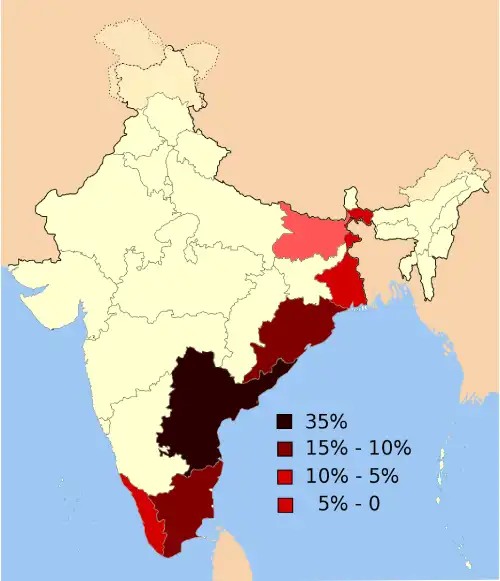
Unlike uranium, thorium is not fissile, meaning it cannot sustain a nuclear chain reaction on its own. However, it is fertile. When bombarded with neutrons, thorium-232 transforms into uranium-233 (U‑233), a fissile material that can power a nuclear reactor.
Thorium is not just an alternative nuclear fuel; it is a national resource capable of providing clean, abundant, and secure energy to India for generations, with less risk and less waste than conventional uranium-based systems.
- India holds nearly 30% of the world’s thorium reserves, primarily along the eastern and southern coastal sands.
- In contrast, India has scarce uranium reserves, making thorium a strategic alternative for long-term energy independence.
- Thorium fuel cycles produce significantly less long-lived radioactive waste compared to uranium or plutonium.
- It offers a safer, cleaner form of nuclear energy, ideal in the era of climate change and energy transition.
- In molten salt or advanced reactors, thorium has passive safety properties: less pressure, lower risk of meltdown, and self-regulating reactivity. Molten Salt Reactors (MSRs) operate at low pressure, reducing the risk of explosions.
- Reactors using thorium (like MSRs) can be designed to be fail-safe in emergencies.
- Unlike uranium-235 or plutonium, thorium doesn’t directly produce fissile material suitable for nuclear weapons.
- This makes thorium reactors less attractive for military misuse, promoting nuclear disarmament goals.
- The thorium-U-233 cycle could power India for over 400 years without needing imported fuel.
- It aligns with India’s Three-Stage Nuclear Programme, a vision laid out by Dr. Homi Bhabha in the 1950s.
India’s Early Leadership in Thorium Research
The Potential of Thorium Nuclear Energy in India began in the 1950s under the leadership of Dr. Homi Jehangir Bhabha, the architect of India’s nuclear program. Recognizing India’s limited uranium reserves and vast thorium resources, Bhabha proposed the “Three-Stage Nuclear Power Program,” a phased strategy to achieve energy independence through the utilization of thorium.
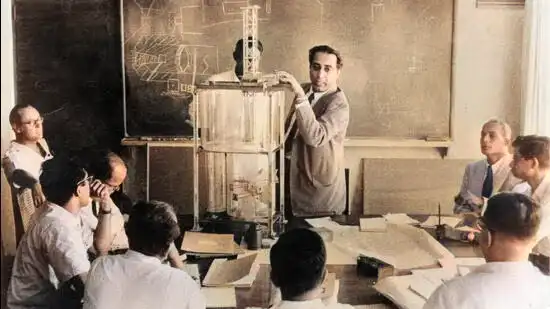
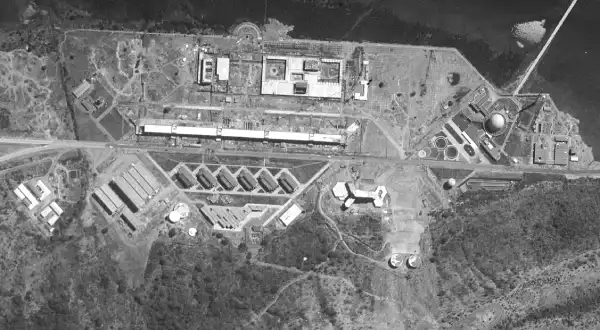
The program was scientifically sound and uniquely suited to India’s geological realities. In 1996, the Kamini reactor at Kalpakkam became the first and only reactor in the world to run on U-233 derived from thorium. Additionally, the Advanced Heavy Water Reactor (AHWR), conceptualized by BARC, was designed to use thorium directly. However, decades later, AHWR remains decommissioned.
This led to the formulation of India’s Three-Stage Nuclear Power Programme:
- Stage I: Use of Pressurized Heavy Water Reactors (PHWRs) fueled by natural uranium to generate plutonium.
- Stage II: Deployment of Fast Breeder Reactors (FBRs) using plutonium from Stage I to breed uranium-233 (U-233) from thorium to generate more fissile material and convert thorium into Uranium‑233 (U‑233).
- Stage III: Commercialization of thorium reactors using U-233 as fissile material to produce sustainable nuclear energy.
The strategic brilliance of this plan lay in the abundance of thorium (~650,000 tons) in India, compared to the country’s meager uranium reserves (~92,000 tons).
India’s thorium journey was not built on vague optimism but on firm scientific reasoning and strategic foresight. Here are documented views from the three greatest minds behind India’s nuclear program:
Statements from India’s Nuclear Pioneers
Subsequent scientists like Dr. Vikram Sarabhai and Dr. A.P.J. Abdul Kalam upheld this vision. Kalam, in his book Target 3 Billion, emphasized thorium’s potential to deliver clean and indigenous energy, particularly for rural electrification.
Dr. Homi Jehangir Bhabha (1954)
“The total reserves of thorium in India amount to over 500,000 tons … The aim of a long‑range atomic power programme in India must … be to base the nuclear power generation as soon as possible on thorium rather than uranium… The first generation of atomic power stations based on natural uranium … can only be used to start an atomic power programme. The plutonium produced … can be used … to convert thorium into U‑233 …”
In a 1954 address at the Conference on the Development of Atomic Energy for Peaceful Purposes, Bhabha stated:
“The aim of a long-range atomic power programme in India must be to base the nuclear power generation as soon as possible on thorium rather than uranium.”
Bhabha not only recognized thorium’s abundance but also engineered the Three-Stage Nuclear Programme specifically to convert it into usable energy via plutonium and U‑233.
Dr. Vikram Sarabhai
While better known for his space achievements, Sarabhai supported Bhabha’s thorium-driven approach, advocating for peaceful and Indigenous nuclear development:
“We must develop nuclear energy for peaceful purposes. It is essential to our progress that India becomes self-reliant in this critical technology.”
Dr. A.P.J. Abdul Kalam
In Target 3 Billion and numerous speeches, Kalam repeatedly called for India to leverage thorium for rural energy independence:
“India has to develop the thorium-based reactor technology to meet the future power demand and achieve energy independence. It is not just a scientific goal; it is a national mission.”
Kalam also endorsed and promoted the AHWR design, calling it essential to India’s long-term energy security and self-reliance.
Achievements and Stagnation
India’s Department of Atomic Energy (DAE) and Bhabha Atomic Research Centre (BARC) pursued thorium-related research:
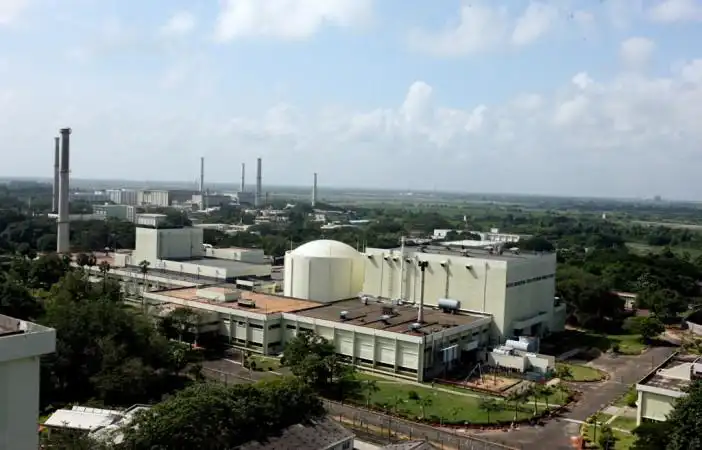
- In 1996, India commissioned the Kamini reactor at Kalpakkam; the world’s only functioning reactor using U‑233 derived from thorium. However, it was limited to experimental and isotope production purposes.
- The Advanced Heavy Water Reactor (AHWR) was designed as a thorium prototype using U‑233 and LEU (low-enriched uranium) to produce 300 MW of electricity. Its development began in the early 2000s, but commercial deployment remains elusive even in 2025.
India’s progress has been largely confined to the research phase. While thorium is regularly cited in government energy reports and scientific papers, the absence of pilot or commercial-scale thorium reactors reflects a deep policy and execution vacuum.
As former Chairman of the Atomic Energy Commission, Dr. Anil Kakodkar, pointed out in a 2010 interview:
“Thorium is our strategic asset. But due to international dynamics and constraints, our attention has been diverted from its timely exploitation.”
Global Developments: China Leads in the Thorium Revolution
Summary Table: Global Thorium Readiness
| Country | Thorium Reserves (Metric Tons) | Status | Position |
|---|---|---|---|
| China | Moderate ~100,000 | Operational prototype, commercial plans | Global leader |
| India | Largest ~846,000 | Research-level only (Kamini), stalled AHWR | Visionary, but On hold |
| USA | Low ~595,000 | Private revival, no govt push | Dormant innovator |
| Canada | Low ~100,000 | Private R&D in MSRs | Early development |
| Norway | Moderate ~132,000 | Test reactor shut down | Inactive |
| Australia | High ~595,000 | No nuclear program | Untapped potential |
| Russia | Moderate ~75,000 | No known thorium focus | Watchful |
Figures above are based on data from sources such as the International Atomic Energy Agency (IAEA) and the U.S. Geological Survey (USGS). Reserves are approximate and inferred based on monazite content and government geological data.
India leads globally, with thorium-rich sands found in Kerala, Tamil Nadu, Odisha, and Andhra Pradesh, while China’s low reserves haven’t stopped it from becoming the technological leader.
Other nations are cautiously exploring thorium, primarily through private enterprises:
- United States: Companies like Flibe Energy and ThorCon are attempting to commercialize thorium MSRs.
- Canada: Firms like Moltex Energy are developing hybrid salt reactor designs.
- Norway and Australia: Research-level interest exists, but policy and public resistance hinder progress.
China’s Rise
While India’s thorium program remains stuck at the research level, China has decisively pulled ahead in developing molten salt reactor (MSR) technology, one of the most promising applications of thorium-based nuclear power. In 2011, the Chinese Academy of Sciences launched the Thorium Molten Salt Reactor (TMSR) project with a clear roadmap: develop a working reactor, scale it up for inland use, and integrate it with China’s broader clean energy and geopolitical strategy.
By October 2023, China’s 2 MW thermal research reactor TMSR-LF1, located in Wuwei, Gansu Province, achieved criticality, marking a historic milestone in thorium reactor development. Just months later, in June 2024, the reactor reached full power operation. In an unprecedented achievement, Chinese scientists successfully carried out online refueling in late 2024, adding fresh thorium salt into the reactor without shutting it down. This capability, once considered theoretical, is now a demonstrated reality in China, placing it at the frontier of next-generation nuclear technology.
China’s plan doesn’t stop at research. It is already constructing a 10 MW electric (60 MW thermal) thorium demonstration plant in the Gobi Desert, scheduled for completion between 2025 and 2029. The ultimate goal is the deployment of 373 MW thermal commercial reactors by the early 2030s, designed not only for electricity generation but also for clean hydrogen production and use in remote inland grids, a direct parallel to the energy needs of many Indian regions. These developments are part of a broader strategy to leverage thorium’s safety, scalability, and low waste output, all while integrating nuclear power into China’s Belt and Road Initiative. By building technological leadership in thorium reactors, China is not just solving domestic energy challenges; it is preparing to export a nuclear future.
China’s approach is methodical and strategic:
- Reviving U.S. Research: The original MSR technology was developed at Oak Ridge National Laboratory in the U.S. during the 1960s, but was abandoned due to political reasons.
- State-Backed Investment: China’s thorium program is centrally funded and guided by long-term policy priorities.
- In 2011, China launched the Thorium Molten Salt Reactor (TMSR) project under the Chinese Academy of Sciences. By 2021, it had completed a 2 MW experimental molten salt reactor in Wuwei, Gansu Province, operational and ready for testing.
- China plans to commercialize thorium reactors in the 2030s, particularly to power its remote inland regions, reduce dependence on fossil fuels, and export thorium technology through its Belt and Road Initiative.
Today, China is capitalizing on that gap, while India, the world’s most thorium-rich nation, stands still.
Where India Is Falling Behind
Despite a robust scientific foundation and access to natural thorium, India has failed to transition from research to deployment. Key reasons include:
The Shift in Political Priorities
- After Prime Minister Indira Gandhi, who supported nuclear self-reliance, successive governments across party lines failed to prioritize thorium development.
- The 2008 Indo-U.S. Civil Nuclear Agreement significantly altered India’s nuclear energy strategy. In return for access to international nuclear markets, India agreed to expand its uranium-based reactor fleet, including imported Light Water Reactors (LWRs). This move diluted the urgency to complete the thorium cycle.
- Funding Gaps: Thorium projects remain underfunded compared to uranium-based initiatives.
- Lack of Political Urgency: Unlike China, thorium is absent from India’s mainstream energy discourse.
- The AHWR, announced with optimism over two decades ago, is still not operational. Bureaucratic delays and shifting priorities have turned a once-promising project into a symbol of stagnation.
Technological Complexity
- Thorium is not fissile on its own; it must be converted into uranium-233 in a reactor, which adds a layer of complexity to the fuel cycle.
- This requires fast breeder reactors or accelerator-driven systems, which India is still developing (e.g., PFBR is still not operational as of 2025).
- Handling U-233 is more difficult due to high gamma radiation from U-232 contamination, demanding advanced shielding and remote handling tech.
Lack of Industrial-Scale Demonstration
- The AHWR (Advanced Heavy Water Reactor) remains a prototype, designed but not yet commissioned.
- India has not built a full-scale commercial thorium reactor, while countries like China have moved forward with molten salt reactor prototypes.
- Experimental successes like KAMINI are limited in scale and not designed for energy generation.
Skill and Expertise Gap
- There is a shortage of specialized nuclear engineers and reactor designers trained in thorium fuel cycles.
- Most educational and research programs still focus on uranium and light water reactor technologies.
- Thorium research demands cross-disciplinary expertise (nuclear physics, chemical reprocessing, materials science), which is underdeveloped.
Underdeveloped Fuel Reprocessing Ecosystem
Efficient thorium use requires:
- Extraction and purification of thorium from monazite
- Fabrication of thorium oxide fuel
- Handling and recycling of U-233
- India has limited infrastructure for thorium reprocessing, and no commercial-scale reprocessing plants for U-233 exist yet.
Funding and Private Sector Involvement
- Thorium reactor development has been largely state-funded and confined to institutions such as BARC and IGCAR.
- There’s very little private investment or international collaboration, unlike in the solar or hydrogen energy sectors.
- The lack of clear returns and long development timelines makes thorium unattractive to commercial investors.
Regulatory and Institutional Bottlenecks
- India’s nuclear establishment is highly centralized and cautious, often reluctant to adopt experimental designs for safety and liability reasons.
- Bureaucratic inertia and the absence of a flexible, innovation-oriented policy framework slow decision-making.
- The Atomic Energy Act of 1962 tightly controls nuclear technology, limiting public-private partnerships.
Despite these advantages, the lack of political will, public investment, and industrial push continues to hinder India’s exploitation of its thorium potential.
India risks long-term strategic setbacks
- Becoming a net importer of thorium reactor technology, despite holding one of the world’s largest thorium deposits
- Missing the opportunity to lead globally in clean nuclear innovation
- Continued dependence on fossil fuels and imported uranium
India must urgently revisit and revitalize its thorium strategy. Key recommendations include:
- Fast-track the commissioning of AHWR
- Increase public and private funding for thorium and MSR research
- Establish international collaborations with China, the U.S., and Canadian firms working on thorium technologies
- Launch a national thorium mission akin to ISRO or the Green Hydrogen Mission
- Integrate thorium research into energy policy and national discourse
The Cost of Inaction
India’s continued dependence on imported uranium poses several strategic risks:
- Energy insecurity: Vulnerable to global supply shocks.
- Economic burden: Long-term costs of importing uranium and foreign-built reactors.
- Lost leadership: India may eventually be forced to import thorium reactors from China, a nation with fewer thorium resources but greater urgency.
India is also missing the opportunity to:
- Lead in next-gen clean energy exports
- Solve its rural energy access problem
- Reduce long-term carbon emissions and waste storage costs
Conclusion
India once led the world in the thorium vision, as Thorium is India’s untapped nuclear goldmine. Scientists Bhabha, Sarabhai, and Kalam laid a scientific and strategic foundation that remains valid even today. But vision without action leads to stagnation. As the world seeks clean and safe energy alternatives, thorium represents a path India can, and must, lead. The time to act is now. Any further delay risks turning India from a potential pioneer into a passive observer in the global thorium revolution.
India does not lack science, talent, or raw materials; it lacks execution and urgency. The legacy of Bhabha, Sarabhai, and Kalam demands more than ceremonial tributes; it calls for bold investment, fast-tracked projects, and strong policy intervention. If India does not act now, it will cede not only technological sovereignty but also the moral leadership in sustainable energy it once claimed to pioneer.
Also Read:
- Homi Bhabha’s Death: An Unfortunate Accident or the Hands of the Crow.
- The Strange Disappearance of India’s Nuclear Scientists.
- North Korea Arms Russia: A Mirror to Global Proxy Warfare
Sources
- Parikh, Harsh. “Thorium in India.“
- “Details of Thorium Reserves,” Government of India, Department of Atomic Energy, 10 May 12.
- “Energy Statistics India – 2023,” National Statistical Office, Government of India, March 2023.
- N. K. Deb, “Nuclear Power – A Future Realistic,” in 75 Years of Indian Independence: The Changing Landscape, edited by D. Das (B. D. Prakash, 2023).
- Parekh, Shiv. “India’s Three-Stage Nuclear Program.“
- Availability of Thorium, Press Information Bureau, Government of India, 10 August 2011
- Rahman, Maseeh (1 November 2011a), “How Homi Bhabha’s vision turned India into a nuclear R&D leader”, The Guardian
- Bhabha, Homi J. Development of Atomic Energy for Peaceful Purposes in India. Ministry of Information and Broadcasting, Government of India, 1958.
- Bhabha, Homi J. Collected Scientific Papers. Indian National Science Academy, 1985.
- Sarabhai, Vikram. Collected Works of Vikram Sarabhai. Vol. 2, edited by C. Ramachandra Rao, Indian Space Research Organisation, 2000.
- Subramanian, T. S. “Vikram Sarabhai: A Life.” Frontline, The Hindu Group, 2001.
- Kalam, A. P. J., and Srijan Pal Singh. Target 3 Billion: PURA; Innovative Solutions Towards Sustainable Development. Penguin Books, 2011.
- Kalam, A. P. J. Ignited Minds: Unleashing the Power Within India. Penguin Books India, 2002.
- Kalam, A. P. J. “Inaugural Address at the International Conference on Energy, 2003,” APJ Abdul Kalam Foundation.
- Karnad, Bharat. India’s Nuclear Policy. Praeger Security International, 2008.
- Ramana, M. V. The Power of Promise: Examining Nuclear Energy in India. Penguin Books, 2012.
- Bhabha Atomic Research Centre – Thorium and AHWR Research
- Department of Atomic Energy – India’s Three-Stage Nuclear Programme
- Indira Gandhi Centre for Atomic Research – Kamini & Breeder Reactor Info
- Atomic Minerals Directorate – Thorium Reserve Maps and Monazite Data
- International Atomic Energy Agency – Thorium Fuel Cycle Report
- World Nuclear Association – Thorium
- U.S. Geological Survey – Thorium in Mineral Commodity Summaries
- China Fires Up First Next-Generation Nuclear Reactor – Bloomberg
- China’s Thorium Bet – MIT Technology Review
- Dr. Anil Kakodkar on the Thorium Path – The Hindu
- Why Thorium is Still Not Powering India – The Indian Express
- What Happened to India’s Thorium Plans – Times of India
- Oak Ridge National Laboratory – Molten Salt Reactor Experiment (MSRE)
- Chinese Academy of Sciences – Thorium MSR Program
- Moltex Energy – Thorium MSR and Stable Salt Reactor
- Flibe Energy – Liquid Fluoride Thorium Reactor (LFTR)
FACT CHECK: We strive for accuracy and fairness. But if you see something that doesn’t look right, please Contact us.
DISCLOSURE: This Article may contain affiliate links and Sponsored ads, to know more please read our Privacy Policy.
Stay Updated: Follow our WhatsApp Channel and Telegram Channel.
